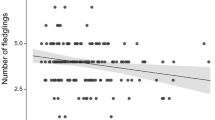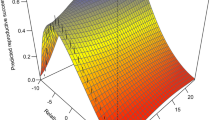Abstract
Individual birds within a population often lay clutches of very different sizes1,2, even though those laying the larger clutches tend to produce more young which survive to enter the subsequent breeding population (recruits)3. Two hypotheses have been proposed to account for such differences in clutch size4. The individual optimization hypothesis proposes that parents lay that size of clutch from which they can maximize recruitment: adding or taking away young from their nests will result in lowered recruitment5. The trade-off hypothesis assumes a cost of reproduction; the rearing of offspring leads to the parents having a lowered future survival or fecundity6,7. When given experimentally enlarged broods to rear parents should therefore show an increased mortality or reduced fecundity. We tested the predictions of these two hypotheses by manipulating the brood size of great tits Parus major over nine years, and following subsequent survival of offspring and parents and future breeding performance of parents. Parents differed in their ability to recruit offspring, this being reflected in the size of clutch that they laid. Parents did best, in terms of the number of offspring recruited, by rearing their own clutch size: adding or removing young did not increase recruitment rates. These results strongly support the individual optimization hypothesis. There was no evidence that parents raising enlarged broods suffered a higher mortality or decreased fecundity compared with those which raised their own natural or decreased broods. We are therefore unable to establish a cost of reproduction and consequently the predictions of the trade-off hypothesis are not supported.
This is a preview of subscription content, access via your institution
Access options
Subscribe to this journal
Receive 51 print issues and online access
$199.00 per year
only $3.90 per issue
Buy this article
- Purchase on Springer Link
- Instant access to full article PDF
Prices may be subject to local taxes which are calculated during checkout
Similar content being viewed by others
References
Lack, D. Population Studies of Birds (Oxford University Press, London, 1966).
Murphy, E. C. & Haukioja, E. in Current Ornithology Vol. 4 (ed. Johnston, R. F.) 141–180 (Plenum, New York, 1986).
Boyce, M. S. & Perrins, C. M. Ecology 68, 142–153 (1987).
Nur, N. in Perspectives in Ethology Vol. 7 (eds Bateson, P. P. G. & Klopfer, P. H.) 49–77 (Plenum, New York, 1987).
Perrins, C. M. & Moss, D. J. Ánim. Ecol. 44, 659–706 (1975).
Williams, G. C. Am. Nat. 100, 687–690 (1966).
Charnov, E. L. & Krebs, J. R. Ibis 116, 217–219 (1974).
Lack, D. The Natural Regulation of Animal Populations (Oxford Univ. Press, London, 1954).
Numerical Algorithms Group The GLIM System Release 3.77 Manual (Numerical Algorithms Group Ltd, Oxford, 1986).
Perrins, C. M. J. Ánim. Ecol. 34, 601–647 (1965).
Perrins, C. M. British Tits (Collins, London, 1979).
Hogstedt, G. Science 210, 1148–1150 (1980).
Author information
Authors and Affiliations
Rights and permissions
About this article
Cite this article
Pettifor, R., Perrins, C. & McCleery, R. Individual optimization of clutch size in great tits. Nature 336, 160–162 (1988). https://doi.org/10.1038/336160a0
Received:
Accepted:
Issue Date:
DOI: https://doi.org/10.1038/336160a0
This article is cited by
-
No evidence for associations between brood size, gut microbiome diversity and survival in great tit (Parus major) nestlings
Animal Microbiome (2023)
-
A review of iteroparity in anadromous salmonids: biology, threats and implications
Reviews in Fish Biology and Fisheries (2023)
-
Mothers with higher twinning propensity had lower fertility in pre-industrial Europe
Nature Communications (2022)
-
Continent-wide genomic signatures of adaptation to urbanisation in a songbird across Europe
Nature Communications (2021)
-
A consistent long-lasting pattern of spatial variation in egg size and shape in blue tits (Cyanistes caeruleus)
Frontiers in Zoology (2018)
Comments
By submitting a comment you agree to abide by our Terms and Community Guidelines. If you find something abusive or that does not comply with our terms or guidelines please flag it as inappropriate.



